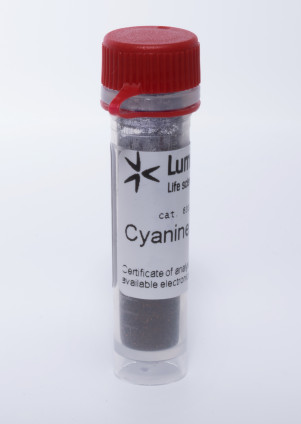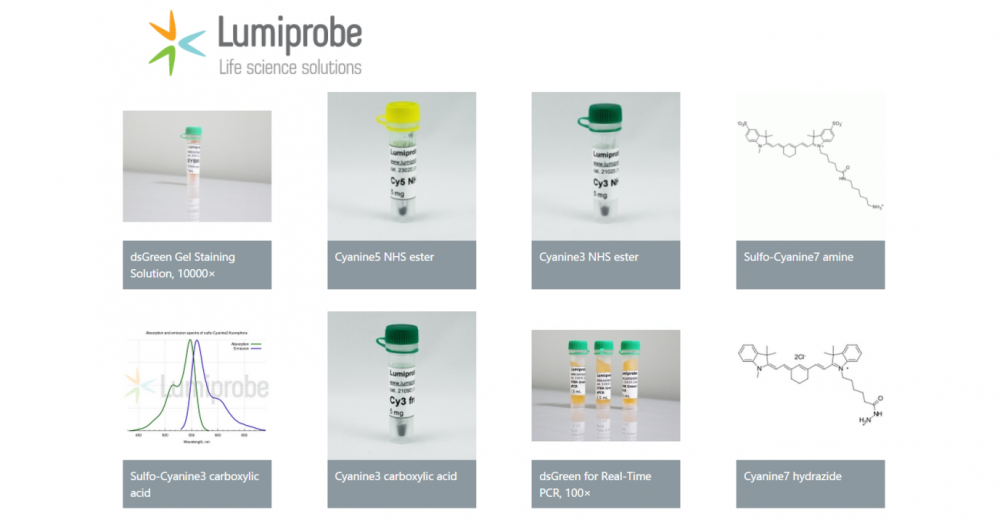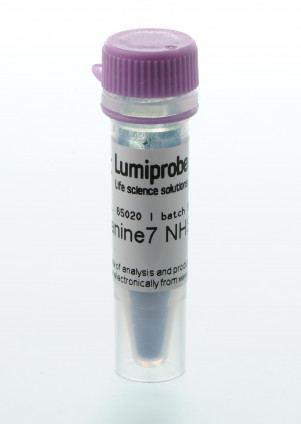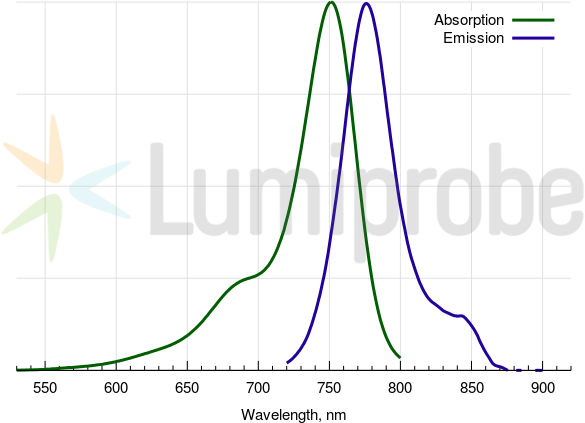Lumiprobe Cy5 NHS 酯 Cyanine5 NHS ester
上海金畔生物代理Lumiprobe品牌产品,欢迎新老客户访问Lumiprobe官网或者咨询我们获取更多相关产品信息。
During the last years, Cyanine5 (an analog of Cy5®) has become an incredibly popular label in life science research and diagnostics. The fluorophore has its emission maximum in the red region, where many CCD detectors exhibit maximum sensitivity, and biological objects show low background. The dye color is very intense, therefore quantities as small as 1 nmol can be detected in gel electrophoresis by naked eye.
This Cyanine5 NHS ester (analog to Cy5® NHS ester) is a reactive dye for the labeling of amino-groups in peptides, proteins, and oligonucleotides. This dye requires a small amount of organic co-solvent (such as DMF or DMSO) to be used in labeling reactions (please see our recommended protocol for more details). This reagent is ideal for very cost-efficient labeling of soluble proteins as well as all kinds of peptides and oligonucleotides. This reagent also works well in organic solvents for small molecule labeling. For more sophisticated targets such as easily degradable proteins, when the use of DMF or DMSO is undesirable, consider using water-soluble sulfo-Cyanine 5 NHS ester which does not require any co-solvent, and features very similar fluorescent properties.
Cyanine5 fluorophore is compatible with various instrumentation including many fluorescent microscopes, imagers, scanners, and fluorescence readers. A number of various Cyanine5 analogs exist – Cyanine5 NHS ester can replace activated esters of Cy5®, Alexa Fluor 647, and DyLight 649.
General properties
| Appearance: | dark blue powder |
| Molecular weight: | 616.19 |
| CAS number: | 1032678-42-4, 350686-88-3 |
| Molecular formula: | C36H42ClN3O4 |
| Solubility: | good in polar (DMSO, DMF) and chlorinated (DCM, chloroform) organic solvents, low solubility in water |
| Quality control: | NMR 1H, HPLC-MS (95%) |
| Storage conditions: | Storage: 12 months after receival at -20°C in the dark. Transportation: at room temperature for up to 3 weeks. Avoid prolonged exposure to light. Desiccate. |


Spectral properties
| Excitation maximum, nm: | 646 |
| ε, L⋅mol−1⋅cm−1: | 250000 |
| Emission maximum, nm: | 662 |
| Fluorescence quantum yield: | 0.2 |
| CF260: | 0.03 |
| CF280: | 0.04 |

| Cat. # | Quantity | Lead time |
| 13020 | 1 mg | in stock |
| 23020 | 5 mg | in stock |
| 43020 | 25 mg | in stock |
| 53020 | 50 mg | in stock |
| 63020 | 100 mg | in stock |
Product citations 参考文献
- Li, L.; Sun, W.; Li, L.; Liu, Y.; Wu, L.; Wang, F.; Zhou, Z.; Zhang, Z.; Huang, Y. A pH-responsive sequential-disassembly nanohybrid for mitochondrial targeting. Nanoscale, in press. doi: 10.1039/c6nr07004c
- Matsuo, Y.; Maurer, S.P.; Yukawa, M.; Zakian, S.; Singleton, M.R.; Surrey, T.; Toda, T. An unconventional interaction between Dis1/TOG and Mal3/EB1 promotes the fidelity of chromosome segregation. Journal of Cell Science. doi: 10.1242/jcs.197533
- Stephen, Z.R.; Gebhart, R.N.; Jeon, M.; Blair, A.A.; Ellenbogen, R.G.; Silber, J.R.; Zhang, M. pH-Sensitive O6-Benzylguanosine Polymer Modified Magnetic Nanoparticles for Treatment of Glioblastomas. Bioconjugate Chemistry, in press. doi:10.1021/acs.bioconjchem.6b00545
- Bloch, M.B.D.; Yavin, E.; Nissan, A.; Ariel, I.; Kenett, R.; Brass, D.; Rubinstein, A. The effect of linker type and recognition peptide conjugation chemistry on tissue affinity and cytotoxicity of charged polyacrylamide. Journal of Controlled Release, in press. doi:10.1016/j.jconrel.2016.06.038














































